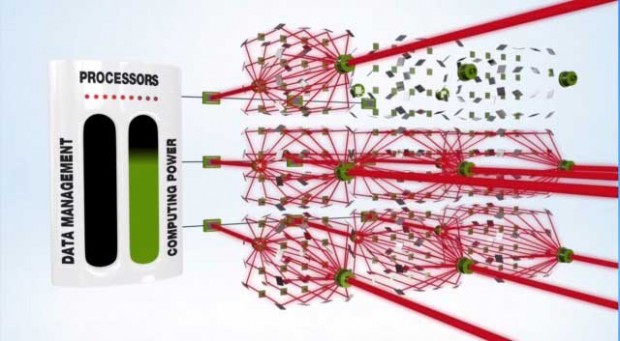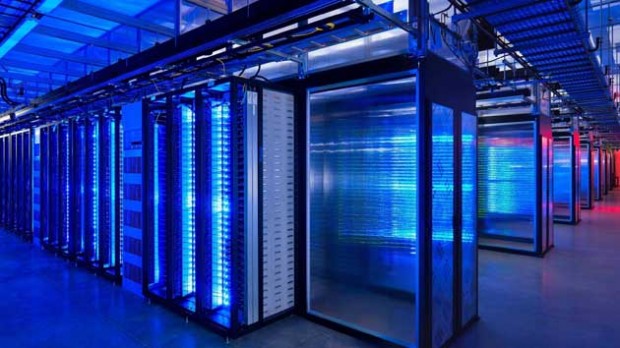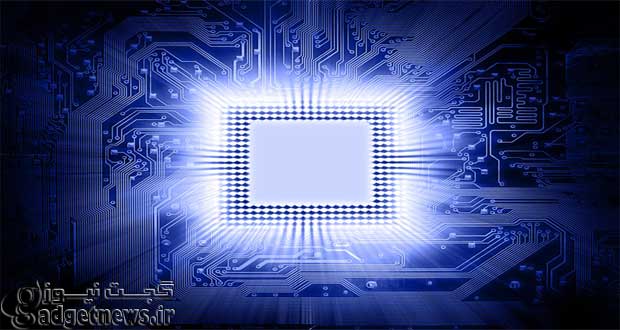همه ما می دانیم که انتقال اطلاعات با تکنولوژی کابل نوری بسیار سریعتر از سیم های مسی می باشد. به عنوان مثال می توان به فیبر های نوری اشاره کرد که نسبت به خطوط تلفن قدیمی هزاران برابر سریعتر هستند. از طرفی انتقال اطلاعات با سرعت بسیار بالا به تنهایی به افزایش سرعت کامپیوتر ها کمک نمی کند و قدرت پردازش اطلاعات دریافت شده نیز باید افزایش یابد.
یک شرکت انگلیسی بنام Optalsys ادعا کرده است که در سال 2015 کامپیوتری را معرفی می کند که می تواند با سرعت نور محاسبات را انجام دهد. این شرکت همچنین عنوان کرده که ابر کامپیوتر عظیم این شرکت در سال 2020 رونمایی می شود.
واژه “پردازش نوری” به نوع بسیار متفاوتی از تکنولوژی اشاره می کند و به طور کلی به سیستم هایی اشاره می کند که به جای نیروی الکتریسیته از نور برای انجام کارها استفاده می کند. روش Optalsys جهت پردازش اظلاعات از لیزر کم قدرت و شبکه کریستال مایع بهره می برد که با دیگر روش های محاسبات نوری متفاوت می باشد و نتایج بدست آمده از آن بسیار امید بخش است.
در این روش لیزر به شبکه کریستال مایع تابیده می شود و باعث انعکاس لیزر در شبکه می شود. با این کار می توان الگوریتم های مورد نظر را پیاده سازی کرد و هزاران و یا حتی میلیون ها محاسبه را بطور همزمان انجام داد. با استفادده از چندین شبکه بصورت موازی می توان بطور چشمگیری قدرت پردازشی اطلاعات را افزایش داد.

مزیت دیگر این روش میزان مصرف توان می باشد. اطلاعاتی که کمپانی Optalsys ارائه می دهد نشان می دهد که این روش بطور غیر قابل باوری باعث صرفه جویی در مصرف برق می شود. یک کامپیوتر نوری بطور میانگین سالیانه 3500 دلار انرژی الکتریکی مصرف می کند. این در حالی است که ابر رایانه های امروزی در صورتی که با حداکثر توان خود کار کنند سالانه 21 میلیون دلار انرژی الکتریکی مصرف می کنند. یک شرکت با این میزان صرفه حویی چه کارهایی می تواند انجام دهد! البته لازم به ذکر است که شرکت های معدودی همچون Google، Microsoft و Amazon به چنین قدرت پردازشی نیاز دارند.

علاوه بر مصرف کم انرژی، کامپیوتر های نوری همچنین به فضای بسیار کمتری برای ساخت ابر رایانه نیاز دارند. کاهش اندازه ابر رایانه باعث کاهش فضای مورد نیاز و تجهیزات جانبی آن می گردد. دستیابی به قدرت ابر رایانه ها در ماشینی به اندازه سیستم های خانگی می تواند باعث پیشرفت علم در بسیاری از زمینه ها همچون پزشکی، مدل سازی سه بعدی و … شود.
شرکت Optalsys ادعا کرده که نمونه اولیه این سیستم ها در سال 2015 رونمایی خواهد شد و دو نمونه تجاری آن در سال 2017 در دسترس می باشد. همچنین سخنران این شرکت اعلام کرد که تا سال 2020 ابر رایانه ای با قدرت پردازشی 17.1 exaflops ارائه می کنند. توجه داشته باشید که سریعترین ابر رایانه جهان در حال حاضر سرعتی نزدیک به 34 petaflops دارد! نظر شما در مورد این نوع پردازش چیست؟ به نظر شما با این سیستم ها می توان په بازی هایی را اجرا کرد!
منبع : digitaltrends
COMPUTERS THAT CALCULATE DATA AT THE SPEED OF LIGHT COULD ARRIVE AS EARLY AS 2020
COMPUTERS THAT CALCULATE DATA AT THE SPEED OF LIGHT COULD ARRIVE AS EARLY AS 2020
Most folks know that data travels at much higher speeds and capacities over optical cables than it can over copper equivalents. A prime example is the tremendous transfer speeds available on fiber optic networks, as opposed to copper POTS (plain old telephone service) lines. We’re talking thousands, even millions more times the data. If you think about it, there’s no reason that the technology (or something similar) that allows us to move massive data around from Point A to Point B shouldn’t help speed up our computers too. To that end, an English technology company dubbed Optalysys says that in January 2015, it will demonstrate a prototype optical computer that performs calculations at the speed of light. If all goes well, the company says that we will see exascale supercomputers as early as 2020. What is an optical computer? The term optical computing can refer to many different types of technologies. Basically, it refers to computers that use light, rather than electricity, to perform many of its tasks. While Optalysys’ approach, which employs low-power lasers and a huge liquid crystal grid, is much different from most other competing optical-based models, the company’s results are very promising so far. While highly complicated, the Optalysys approach projects low-power lasers onto the liquid crystal grid, which in turn initiates reactions within the grid. This generates sophisticated algorithms, accommodating thousands, even millions of calculations simultaneously. By using multiple grids, either in sequence or in parallel, you can significantly increase capacity and processing power. In addition to providing massive computing oomph, the Optalysys’ system consumes very little power. The company provided the following statistic to demonstrate the incredible savings in electricity: An optical computer will use roughly $3,500 worth of electricity each year, while today’s most powerful supercomputer, when running at its peak power of 34 petaflops per second, sucks juice at an annual cost of about $21 million. What could a company do with those kinds of power savings? The truth is that very few companies (Perhaps Google, Microsoft, Amazon, and so on) require supercomputers with that kind of processing oomph. Most of us, on the other hand, would have little use for anywhere close to that kind of computing power. Still, in addition to reducing the power bill literally by millions, optical computers should also decrease the size of supercomputers themselves drastically, thereby reducing space requirements and a slew of other expenses associated with housing humongous machines. The ability to deliver supercomputer power in a desktop-size machine opens up possibilities in all kinds of areas, including medicine, digital video and other media editing, 3D modeling, CAD—the list goes on and on. If and when optical computers go mainstream, imagine what such a desktop machine would be capable of. When will we see optical computers? According to Optalysys, its optical computing technology has already met the NASA Technology Readiness Level (TRL) 4. This means that it’s ready for full-scale lab testing. As mentioned, the company says that we’ll see a prototype by January 2015, and that it hopes to have two commercial demo systems up and running by 2017. A big data analysis system for augmenting conventional supercomputers, and a standalone “Optical Solver” supercomputer that, a company spokesman says, should start at 9 petaflops, with it scaling up to 17.1 exaflops could arrive by 2020. However, while the technology itself seems sound, Optalysys is just getting started. With this in mind, the 2020 time frame seems ambitious. If all works out as planned though, the next bunch of years could see some freakishly powerful computers.


 گجت نیوز آخرین اخبار تکنولوژی، علم و خودرو
گجت نیوز آخرین اخبار تکنولوژی، علم و خودرو







